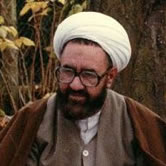
Shaheed Murtadha Mutahhari
استاد شہید مرتضیٰ مطہریؒ
Biography
Murtada Mutahhari was born in a village some forty kilometres from Mashhad on February 3, 1920. After a primary education mostly at the hands of his father, he entered, still a child, the hawzayi `ilmiya, the traditional educational establishment, of Mashhad, but he soon left for Qum, the centre for religious education in Iran. Even during the time of his elementary studies there he was greatly affected by the lessons in akhlaq (Islamic ethics) given by Ayatullah Khumayni, which Mutahhari himself described as being in reality lessons in ma`arif wa sayrusuluk (the theoretical and practical approaches to mysticism) [4], and he later studied metaphysics (falsafa) with him as well as jurisprudence (usul alfiqh) . He was especially attracted by falsafa, theoretical mysticism (`irfan) and theology (kalam) , the
"intellectual sciences
", and he also studied these subjects with `Allama Tabatabai. His teachers in law (fiqh) were all the important figures of the time, but especially Ayatullah Burujirdi, who became the marja` altaqlid, and also head of the hawzayi `ilmiya of Qum, in 1945. Murtada Mutahhari studied both fiqh and usul alfiqh in the classes of Ayatullah Burujirdi for ten years. He was also deeply affected at about this time by lessons on
"Nahj al-Balagha
" [5] given by Mirza `Ali Aqa Shirazi Isfahani, whom he had met in Isfahan. He later said that, although he had been reading this work since his childhood, he now felt that he had discovered a
"new world
".[6] Subsequently, Mutahhari became a well known teacher in Qum, first in Arabic language and literature, and later in logic (mantiq) , usul alfiqh, and falsafa.
In 1952, Murtada Mutahhari moved to Tehran, where, two years later, he began teaching in the Theology Faculty of the University. Not only did he make a strong impression on students, but his move to Tehran also meant that he could become involved with such organizations as the anjuman hayi islami. These Islamic Associations were groups of students, engineers, doctors, merchants, etc., set up during the fifties and sixties; they formed the nucleus of the movement that was to become, eventually, the revolution. He was also a founder member of the Husayniyayi Irshad, which played a central role in the religious life of the capital during the four years of its existence until its closure by the authorities in 1973 [7]. At the same time he maintained his contact with traditional religious activities, teaching first in the Madrasayi Marvi in Tehran, and later back in Qum, and also preaching in mosques in Tehran and elsewhere in the country. Through his lectures and writings -articles and books -he became a famous and muchrespected figure throughout Iran, but it was mainly among the students and teachers of the schools and universities that he was most influential, setting an example and inspiring them as a committed and socially aware Muslim with a traditional education who could make an intellectually appropriate and exciting response to modern secularizing tendencies. His wideranging knowledge and scholarship are reflected in the scope of his writings, which cover the fields of law, philosophy, theology, history and literature.[8] He was also one of the few highranking ulama to be in continuous contact with Ayatullah Khumayni during the fifteen or so years in which the movement which led to the revolution was developing. He was actively engaged in all the stages of this movement.
His life came to an abrupt and untimely end when he was shot in the street by an assassin after a meeting of the Revolutionary Council on the evening of 1 May 1979. Animated mourning accompanied his funeral cortege from Tehran to Qum, where he was buried near the shrine of the sister of the eighth Shi`i Imam.